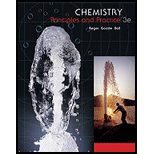
Concept explainers
(a)
Interpretation:
The ground state electronic configuration, the bond order of
Concept Introduction:
The bond order is the number of electrons pairs shared between two atoms in the formation of the bond.
Bond order
Where,
(a)
Explanation of Solution
If one electron is lost by the carbon molecule
The
The ground state electronic configuration of an
Bond order of
The bond order of
(b)
Interpretation:
The ground state electronic configuration, the bond order of
Concept Introduction:
Refer to part (a).
(b)
Explanation of Solution
The ground state electronic configuration of
Bond order of
The bond order of
(c)
Interpretation:
The ground state electronic configuration, the bond order of
Concept Introduction:
Refer to part (a).
(c)
Explanation of Solution
The ground state electronic configuration of
Bond order of
The bond order of
Want to see more full solutions like this?
Chapter 10 Solutions
Chemistry
 Chemistry: Principles and PracticeChemistryISBN:9780534420123Author:Daniel L. Reger, Scott R. Goode, David W. Ball, Edward MercerPublisher:Cengage Learning
Chemistry: Principles and PracticeChemistryISBN:9780534420123Author:Daniel L. Reger, Scott R. Goode, David W. Ball, Edward MercerPublisher:Cengage Learning Chemistry: The Molecular ScienceChemistryISBN:9781285199047Author:John W. Moore, Conrad L. StanitskiPublisher:Cengage Learning
Chemistry: The Molecular ScienceChemistryISBN:9781285199047Author:John W. Moore, Conrad L. StanitskiPublisher:Cengage Learning ChemistryChemistryISBN:9781305957404Author:Steven S. Zumdahl, Susan A. Zumdahl, Donald J. DeCostePublisher:Cengage Learning
ChemistryChemistryISBN:9781305957404Author:Steven S. Zumdahl, Susan A. Zumdahl, Donald J. DeCostePublisher:Cengage Learning
 Chemistry: An Atoms First ApproachChemistryISBN:9781305079243Author:Steven S. Zumdahl, Susan A. ZumdahlPublisher:Cengage Learning
Chemistry: An Atoms First ApproachChemistryISBN:9781305079243Author:Steven S. Zumdahl, Susan A. ZumdahlPublisher:Cengage Learning




